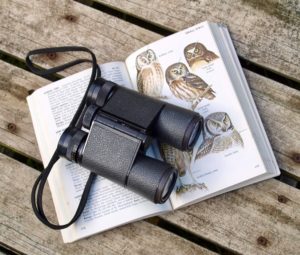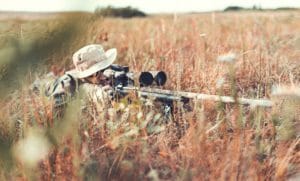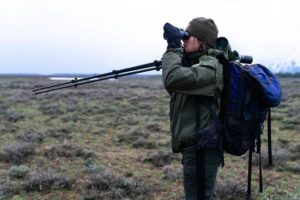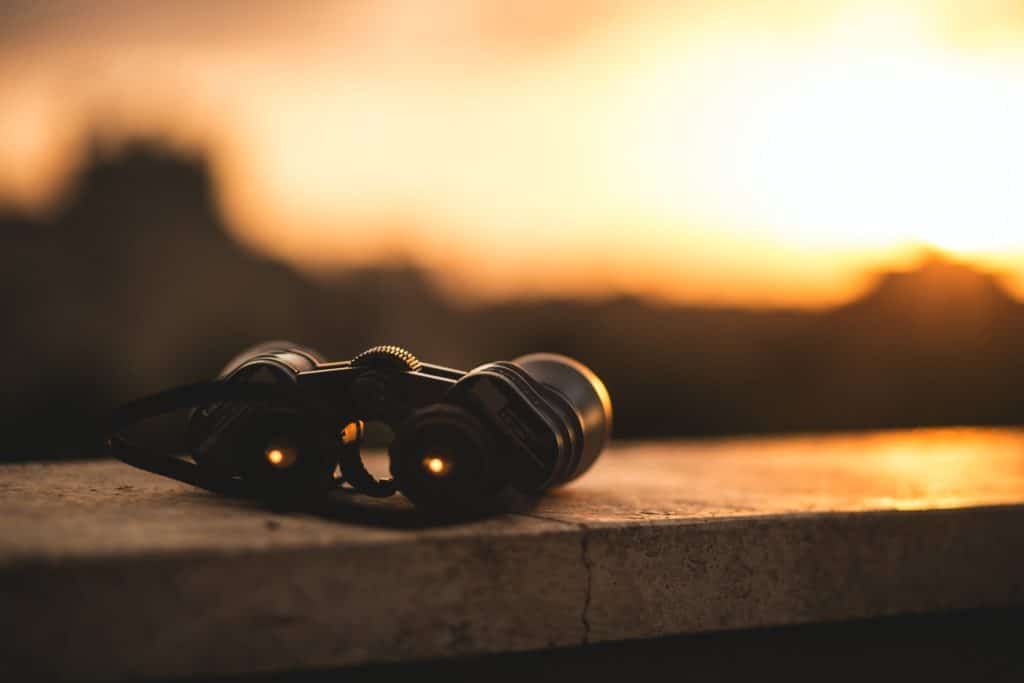If you’re a hunter or work within security or search and rescue, you need to be able to spot targets from a distance as well as in the dark. While some might go for night vision goggles that rely on moonlight, thermal binoculars are able to see through fog, bush, smoke, and dust without visible light.
In this article, we’ll review our top 10 best thermal binoculars for 2021. We’ll also look at exactly what a thermal binocular is and what features determine the best thermal binoculars.
The full list of the best thermal binoculars includes:
- Pulsar Accolade XP50 2.5-20x42 Thermal Binoculars —Best Military Grade Thermal Binoculars
- ATN OTS-HD 640 Thermal Smart HD Monoculars—Best Zoom Range
- Pulsar Axion Key XM30 2.4-9.5x24 Thermal Monocular Black—Most Compact
- ATN Binox 4T 384 4.5-18 Thermal Binocular—Best Battery Life
- FLIR Scout TK Handheld Thermal Imaging Monocular—Best for Short Range
- Leupold LTO-Tracker 2 HD Thermal Viewer—Best Thermal Riflescope
- FLIR Breach PTQ136 Multi-Purpose Thermal Imaging Monocular—Best for Helmet Mounting
- AGM Global Vision Mil Spec Short Range Thermal Imaging Monocular—Most Budget-Friendly
- FLIR Command 336 5-20x75 Thermal Imaging Bi-Ocular—Best Thermal Bi-Ocular
- FLIR LS-XR Handheld Thermal Imaging Monocular—Best for Ocean Scouting
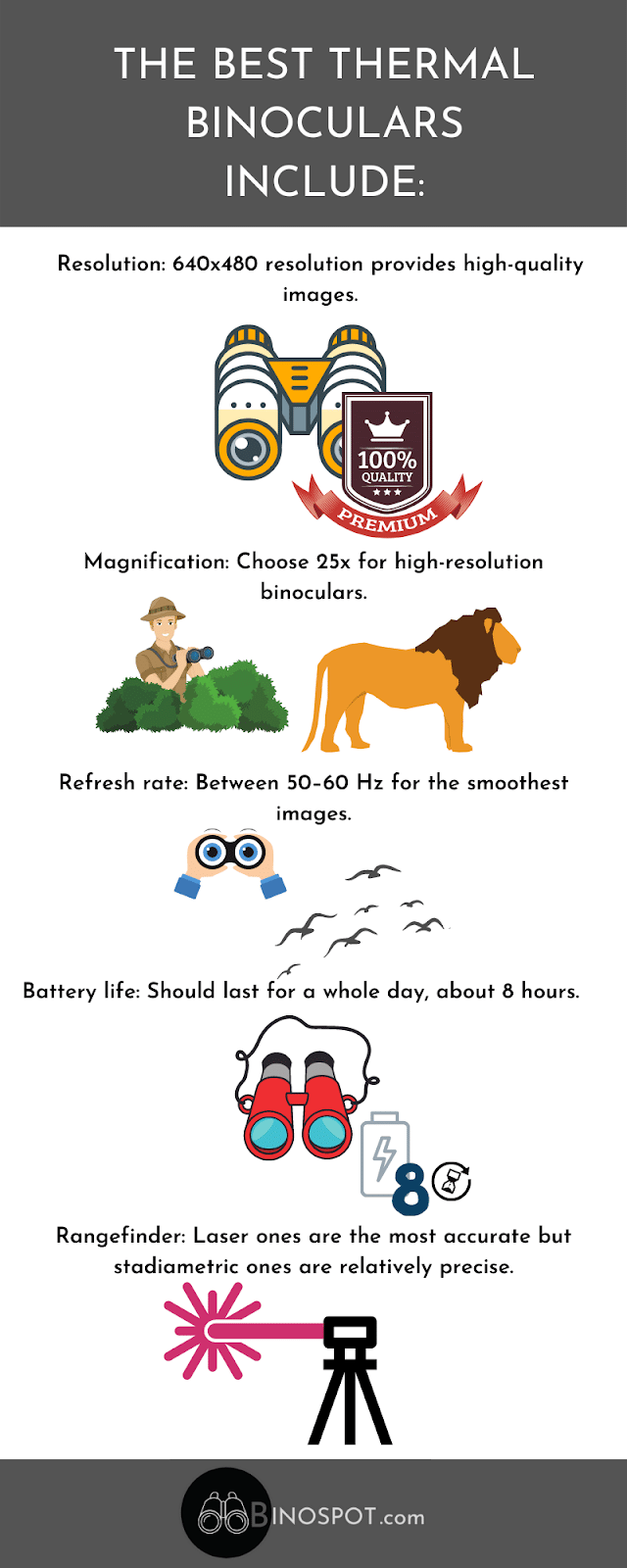
What Is Thermal Imaging?
Thermal optics produce thermograms—pictures of temperature patterns—by collecting infrared radiation. These devices don’t rely on visible light which makes them able to see through fog, smaller bushes, smoke, and in total darkness.
Binocular, Bi-ocular, or Monocular?
These are the three main types of thermal imaging devices:
- Binocular: Just like normal binoculars, these have two objective lenses and two eyepieces. You receive double the amount of information compared to the single-lens devices and they produce higher quality images. These also have a wide field of vision.
- Bi-ocular: Has one objective lens and two eyepieces. Mixes a binocular and monocular. The FLIR Command 336 5-20x75 Thermal Imaging Bi-Ocular is our favorite bi-ocular on the market.
- Monocular: Has one objective lens and one eyepiece. This is usually the cheapest alternative, but it has a shorter field of vision.
The best thermal optic device is a thermal binocular, since it can produce more detailed images. They are usually more expensive, however. On our list, the best binoculars are the Pulsar Accolade XP50 2.5-20x42 Thermal Binoculars .
How To Choose the Best Heat Sensor Binoculars
The best thermal binoculars should produce high-quality, smooth images, and last you for the whole night without needing a recharge. Look for the following features:
Resolution
This is the most important feature of thermal goggles since it determines the quality of your image or video. Depending on your budget as well as your required detection range, I’d advise you to go for different resolutions.
If you want something budget-friendly and will use your binoculars to spot things from 700–1500 yards, go for a pair with 384×288 pixels. Note that these will rapidly lose sharpness as you zoom-in.
Now, for those who want to use their goggles to see things 2000+ yards away, opt for a 640×480 pixels pair. Images from these binoculars won’t lose as much sharpness when zooming. They’re ideal for long-range hunting. One pair with high resolution is the Pulsar Accolade XP50 2.5-20x42 Thermal Binoculars .
Magnification
As you learned in the section above, thermal imager devices with higher resolution lose less sharpness when zooming-in. This means that they work great with higher magnifications such as a 25x zoom. If you work in the marines, for example, you’ll need high magnification to be able to spot things from further away.
The ATN OTS-HD 640 Thermal Smart HD Monoculars have the widest range of zoom on our list.
The extra zoom might be unnecessary to blow your budget on if you hunt in the woods with a lot of trees, since you won’t be able to spot things from such a long distance anyway. Also, if you have lower resolution goggles, stay within the 5–15x zoom range since your binoculars won’t be able to produce sharp images when zooming further.
Refresh Rate
This basically refers to how many frames your binoculars capture per second. The higher the refresh rate, the more fluid and smooth your images will be. If you’re using your device while moving or are following a moving target, the image will be rather choppy if you opt for a lower refresh rate.
The best thermal binoculars have a rate of between 50–60 Hz. On our list, the thermal imager with the highest rate is the ATN Binox 4T 384 4.5-18 Thermal Binocular.
Photo, Video, and Connectivity
Opt for models with video recording and image-taking features if you want to re-watch them later. The best ones should support SD cards and have HD quality. Note that some fields of work can require this, such as some professions within law enforcement.
As for connectivity, if you want to stream your recordings or share images with others, look for binoculars with built-in WiFi and Bluetooth. The AGM Global Vision Mil Spec Short Range Thermal Imaging Monocular has a WiFi-hotspot, for example. Make sure it supports your operating system, whether it’s Android or iOS.
Comfort
A lightweight pair of binoculars won’t make your arms as tired during extended use. When it comes to weight range, light goggles would be less than 1 pound. Small ones are also more portable. You can fit the Pulsar Axion Key XM30 2.4-9.5x24 Thermal Monocular Black in your pocket, for example.
The best thermal optics also have adjustable interpupillary distance, which means that they adjust to the distance between your eyes and fit you better. This will also make them more comfortable to use.
Durability
Hunters might use thermal imagers in wet, cold, and muddy environments. Others might also encounter dust in their profession. To have the most durable binoculars possible, look for features such as water- and dust-proofing. The FLIR Command 336 5-20x75 Thermal Imaging Bi-Ocular is waterproof, for example.
Another thing to consider is how long the battery lasts. A good pair of binoculars should last you during long hunting trips and work shifts and have a battery life of about 8 hours. The imager with the longest battery life on this list is the ATN Binox 4T 384 4.5-18 Thermal Binocular.
Other Features
- Rangefinder: This feature calculates the distance to targets. The best ones are lasers, but stadiametric rangefinders using a telescope are more hidden and still relatively precise.
- Color modes: Binoculars with different color modes are more versatile. A sepia color mode is more appropriate for tracking long-range targets at night, while the violet mode is great at specifically tracking your target in wide areas, for example.
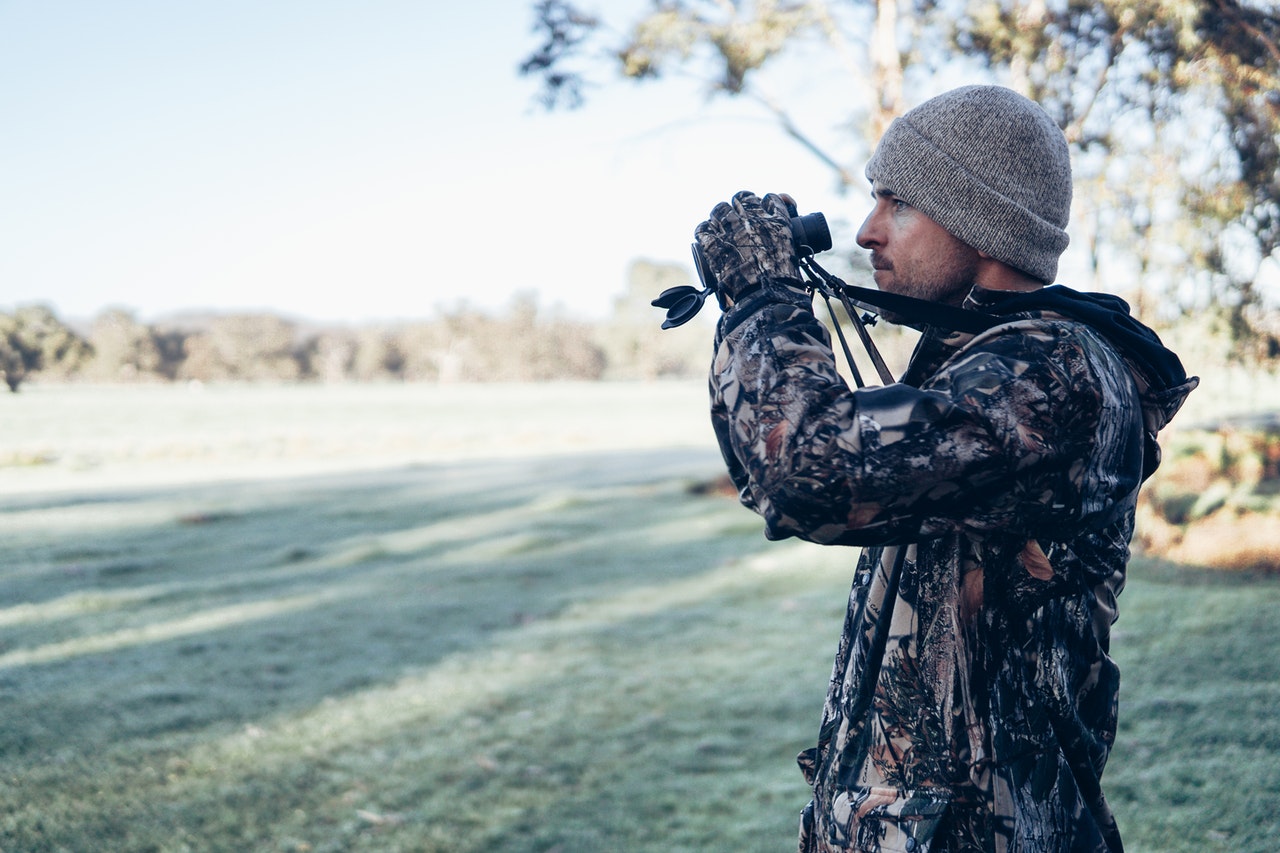
Reviews of the Best Thermal Imager Binoculars
Let’s have a look at the best thermal binoculars, bi-oculars, and monoculars and their pros and cons.
1. Best Military Grade Thermal Binoculars
Features
Type of thermal imager: Binoculars | Resolution: 640×480 | Magnification: 2.5–20x | Refresh rate: 50 Hz | Battery life: 8 hours | Rangefinder: Stadiametric
Description
The Pulsar Accolade XP50 Thermal Binoculars have a high 640×480 resolution and a 50 Hz refresh rate, which makes them able to produce high-quality images without getting choppy. Users agree and testify to seeing a quail of birds in plum bushes from 50 yards away that they would otherwise have missed.
As a matter of fact, these goggles are able to spot targets from up to 2000 yards away. According to customers, you can even identify what animal you’re looking at from a 500-yard distance. The adjustable interpupillary distance makes it even easier to spot targets from far away.
Other nice features are the rechargeable battery with 8 hours of battery life, the built-in video recorder, and WiFi, as well as live streaming. For surveillance officers, recording videos is a great feature. It’s also dust- and waterproof and has a frost-resistant display, which makes it hunting-friendly.
What users also like is that there are eight different observation modes optimized for different types of environments such as forests, mountains, and cities. You can also choose the color-setting you like the most.
Note that this is a pricey pair of binoculars, however. Some users also wish that there was some kind of image stabilizer since it gets rather blurry as you move. Also, the micro USB port is sometimes difficult to connect to.
Pros
- Very high-quality images.
- The battery lasts a long time.
- Video recording and image capturing features.
- WiFi.
- Able to identify animals from afar.
- Eight observation modes.
Cons
- Pricey.
- No image stabilizer.
- Hard to get cables into the USB port.
2. Best Zoom Range
Features
Type of thermal imager: Monoculars | Resolution: 640×480 | Magnification: 2.5–25x or 5–50x | Refresh rate: 30 Hz | Battery life: N/A | Rangefinder: Stadiametric
Description
The ATN OTS-HD 640 Thermal Monoculars will give you images, take photos, and record videos in high 640×480 resolution. This model is equipped with an E-compass that helps you find your way through the forest and WiFi that will keep you connected.
These monoculars come in two versions; one has a 2.5–25x zoom, while the more expensive option has 5–50x zoom. Both of these ranges are impressive, and paired with the high-resolution, you’ll get clear images when zooming-in. A few customers stated that the 2.–25x zoom is enough and that the pixelation gets worse if you zoom in more.
The refresh rate is quite low at 30 Hz, which might affect the blurriness of the image when looking at moving objects. It does have gyroscopic image stabilization, however, which might help make it less blurry if you’re the one moving.
What’s most popular with these monoculars is the clear images they provide. You can spot and identify animals from 1000 yards. Some even stated they could identify larger elk and deer from 2900 yards away. Another popular thing is that it’s easy to hold and scan with.
The manufacturer doesn’t state how long the battery of this unit lasts, but customers feel like the monoculars eat through the battery life. They recommend buying an extra battery pack. Also, the eye relief patches aren’t the best quality, and the protective rubber tends to come off.
Pros
- Clear images.
- Video recording and picture taking.
- Wide range of zoom.
- WiFi.
- Easy to use.
- Gyroscopic image stabilization.
Cons
- Not the greatest battery life.
- Eye protection patches tend to fall off.
- Rather low refresh rate.
3. Most Compact
Features
Type of thermal imager: Monoculars | Resolution: 320×240 | Magnification: 2.5–9.6x | Refresh rate: 50 Hz | Battery life: 4 hours | Rangefinder: No
Description
The Pulsar Axon Key XM30 Thermal Monoculars are extremely lightweight, at 0.55 pounds. One user states that they’re great for an outdoors person on the move who requires maximum tech and minimal weight. They’re compact enough to fit in your pocket. These monoculars are also affordable compared to others on our list.
With a 320×240 resolution, the device provides pretty clear pictures but doesn’t beat the ones with higher resolution. Users really like the automatic digital zoom that helps sharpen images. They also find it super easy to use and that the buttons are easy to access even in the dark—since they’re located on top of the device.
You can choose between eight color settings on the XM30. These monoculars are also waterproof but note that they don’t perform well in sub-degree temperatures, according to users.
One of its biggest cons is that you can’t record videos or take pictures with this device, even though it’s advertised as being able to. It’s possibly not the best alternative for a law enforcement officer. Another thing is that the zoom range isn’t the best, and images also look blurry at the maximum 9.6x zoom.
Pros
- Super light and compact.
- A lot of bang for your buck.
- Automatic zoom.
- Customizable color modes.
- Waterproof.
- Buttons are easy to access.
Cons
- Not able to save pictures or videos.
- Not the best zoom-range.
- Blurry images at close zoom.
4. Best Battery Life
Features
Type of thermal imager: Binoculars | Resolution: 384×288 | Magnification: 4.5–18x | Refresh rate: 60 Hz | Battery life: 16 hours | Rangefinder: Laser
Description
These binoculars are designed to “last longer than any other in the open air,” according to ATN, and have a whopping 16+ hours of battery life. You can enjoy several days of hunting without going home for a recharge.
The built-in laser rangefinder is easier to use and more accurate than a stadiametric one when measuring the distance to targets. It also has a dual-core thermal sensor that automatically adjusts to images to increase their sharpness. All in all, users state that it’s great when watching animals at night.
The fact that these binoculars have a dual-core makes them able to transmit and stream two HD images or videos simultaneously. You can also save them to the built-in SD card. As for the display on the thermal imager, it’s also HD with 1280×720 resolution.
For added comfort, the Binox 4T 384 has adjustable interpupillary distance and soft eye patch releases.
But compared to other binoculars, these have a rather low image resolution. This affects the detection range on this device which is about 1000 yards compared to other products on our list that can reach up to 2000 yards.
Another complaint is that these reportedly get some spots in the image after some time that inaccurately display temperature.
Pros
- Several days of battery life.
- Accurate laser rangefinder.
- Dual streaming features.
- Adjustable interpupillary distance.
- High-resolution HD display.
Cons
- Lower image quality.
- Not the widest detection range for the price.
- The image gets inaccurate spots after some use.
5. Best for Short Range Use
Features
Type of thermal imager: Monoculars | Resolution: 160×120 | Magnification: None | Refresh rate: 9 Hz | Battery life: 5 hours | Rangefinder: No
Description
The FLIR Scout TK monoculars are great for entry-level thermal imaging enthusiasts. They’re cheap, compact enough to carry in one hand, and have the basic features of a thermal optic. Users report using them to look for intruders or animals on their property, as well as spotting hunting targets on open fields.
They perform well within 100 yards and can identify small animals within 75 yards. These monoculars don’t have any magnification and can’t zoom-in on targets far away, but this also means that they’re great for spotting things up-close. Other devices typically start at a 2.5x zoom and might miss animals hiding right in front of them.
For its affordability, it also has many color settings to spot targets in different environments. Customers also feel like it’s super easy to use and great for beginners.
However, the relatively low resolution and lack of zoom features make the image quality lower than other devices on our list. Users also complain about choppy images, probably due to the relatively low 9 Hz refresh rate.
Another complaint is that the battery life is shorter than the advertised 5 hours. Most users state that it only works for about 2–3 hours.
Pros
- Identifies targets very well up close.
- Affordable.
- Portable.
- Good for entry-level thermal imaging.
- Easy to use.
- Many color settings.
Cons
- Not the best image quality.
- Choppy.
- Short battery life.
6. Best Thermal Riflescope
Features
Type of thermal imager: Monoculars | Resolution: 320×240 | Magnification: 1–7x | Refresh rate: 25 Hz | Battery life: 10 hours | Rangefinder: No
Description
These thermal monoculars are great to use on a rifle. They’re lightweight at 0.44 pounds and won’t make it much heavier to carry. You can reportedly hold them in one hand with ease.
Buyers state that this thermal riflescope is easy to set up and pretty straightforward when using it. Several people also testify that this scope is great at seeing footprints left by animals, making them easier to track. Another thing that makes it good for hunters is that it’s waterproof.
But the most popular feature of this device is the beacon mode that allows you to customize the thermal sensitivity after your surroundings. This makes you able to better see your surroundings both at day and night time.
These monoculars are advertised as having a detection range of 750 yards. While this is true, buyers state that you’ll only be able to identify targets from a closer distance of a few hundred yards. The image also gets more pixelated when you zoom in.
Due to the low refresh rate of 25 Hz, the image gets blurry when you try to follow a running target according to users. Also, these monoculars don’t record videos or take pictures. Note that they don’t have rechargeable batteries either.
Pros
- Great fit for rifles.
- Can spot footprints.
- Beacon mode to customize thermal sensitivity.
- Easy to set up.
- Waterproof.
Cons
- Lower refresh rate creates blurry images.
- No rechargeable batteries included.
- No video recording or taking pictures.
7. Best for Helmet Mounting
Features
Type of thermal imager: Monoculars | Resolution: 320×256 | Magnification: 1–4x | Refresh rate: 60 Hz | Battery life: 2.5 hours | Rangefinder: No
Description
As a hunter or any other thermal imager operator who wants to have more maneuverability and less to carry in their hands, this monocular is a great alternative. It comes equipped with a mini-rail needed to attach it to a helmet.
What adds to the appropriateness of helmet mounting with this device is the high 60 Hz refresh rate that keeps images stabilized and smooth even when you and the monocular are moving.
This device is also very effective for short-range scanning. It spots targets within a 200-yard distance, and users state that it has better sensitivity and contrast than your typical 320 resolution imager. They also find the palette settings very nice, especially the black hot outdoor alert.
What’s good to know for law enforcement officers is that this monocular is capable of recording videos and taking pictures.
This is an appropriate thermal imager for close-quarter combat and short-range detection, but it doesn’t have enough detection range, magnification, nor resolution for long-distance scanning. Another con is the short battery life of the FLIR Breach PTQ136. The battery indicator is reportedly also inaccurate.
Further, customers think that the buttons are difficult to press, which might impact speedy response.
Pros
- Easily mounted to a helmet for hands-free operation.
- Smooth and not shaky images.
- Great at short-range hunting and close-quarter combat.
- Good sensitivity.
- Cool and functional palette settings.
Cons
- Rather short detection area.
- Battery life is only about 2.5 hours.
- Buttons aren’t very accessible.
8. Most Budget-Friendly
Features
Type of thermal imager: Monoculars | Resolution: 160×120 | Magnification: None | Refresh rate: N/A | Battery life: 7 hours with WiFi-hotspot off | Rangefinder: N/A
Description
These monoculars are an alternative for those of you who don’t want to blow your budget. It’s significantly cheaper than most other thermal imagers on our list, and users are impressed that you can even live-stream video through the built-in WiFi-hotspot.
AG Global Vision Mil Spec are compact and handheld monoculars, and they’re made for short-range use. Customers report successfully identifying holes in their isolation and hot spots in water pipes. Some also use these in the forest to spot animals from stands at short ranges.
The rechargeable battery is another plus that will save you money. As for the battery life, the manufacturer states that it runs for 7 hours straight without the WiFi on. Note that the life of the battery will be cut significantly shorter if you use the hotspot.
Buyers state that the image quality isn’t the greatest with these monoculars. With a low 160×120 resolution, this isn’t very surprising. It also won’t work for identifying animals over 100 yards away and won’t recognize them when the distance exceeds 200 yards. It’s not ideal for long-range hunting or to be used in open fields.
Some users also report dissatisfaction that the display is small on this device. This might make it more difficult to spot targets.
Pros
- Nice on your wallet.
- WiFi-hotspot with live-streaming functions.
- Compact.
- Rechargeable battery.
- Works well for short-range.
Cons
- Low image quality.
- Not great for long-range.
- Small display.
9. Best Thermal Bi-Ocular
Features
Type of thermal imager: Bi-oculars | Resolution: 336×256 | Magnification: 5–20x | Refresh rate: 30 Hz | Battery life: 4 hours | Rangefinder: No
Description
Do you prefer bi-oculars? Then the FLIR Command 336 is a great alternative that collects information with a 75 mm objective lens. This allows for better depth perception. Its best feature is arguably the long detection range it provides. You can spot targets from a whole 2400 yards away.
Another feature is that these bi-oculars have both optical and digital zoom that makes it more accurate since you can customize it depending on the situation. The 5–20x is also a rather wide zoom range.
The resolution provides decent quality images, and the display has different color settings for the buyer to choose from. One added plus is that these are waterproof bi-oculars.
Users state that these might take some time to set up, but once they’re done, they perform great. What they don’t perform so well in is battery life, however, and the advertised 4 hours life comes from non-rechargeable batteries. Make sure to buy an external battery pack if you opt for this bi-ocular.
Finally, note that you can record videos and take pictures with this device, but only when connecting it to an external video recorder.
Pros
- Better depth perception due to objective lens.
- Large 2400 yards detection range.
- Both digital and optical zoom.
- Waterproof.
- Several color modes.
Cons
- Short battery life.
- Batteries are not rechargeable.
- No built-in video recording feature.
10. Best for Ocean Scouting
Features
Type of thermal imager: Monoculars | Resolution: 640×512 | Magnification: 2, 4, and 8x | Refresh rate: 30 Hz | Battery life: 5 hours | Rangefinder: Laser
Description
Here’s another high-performing monocular from Flir that can detect small vessels out at sea from a distance of 3280 yards. This makes it perfect for search and rescue teams at sea and other ocean scouting.
This monocular is equipped with a red laser pointer that measures distance. This is a very accurate way of determining the distance to the target.
Also, the 640×512 resolution provides good image quality. Note that the zoom isn’t the greatest range, however. Monoculars with a resolution this high could make use of a wider zoom range.
Users really like that this thermal imager only takes seconds to start up and get running. They also feel that it’s compact, lightweight, and easy to carry in one hand. With the equipped wrist strap, you can also secure it around your wrist and prevent it from falling.
Some customers feel like these monoculars are a little too expensive for what you get. The refresh rate isn’t the greatest, which can lead to choppy images, and the battery life is just OK.
Pros
- Can spot objects at sea more than 3000 yards away.
- Laser pointer measures distance accurately.
- Quality images.
- Quick start up.
Cons
- Not the best range of zoom.
- A little pricey.
- Rather low refresh rate for the price.
FAQs Related To Thermal Binoculars
What’s Better Thermal or Night Vision?
Night vision binoculars rely on light to detect targets. They magnify what small light is available, such as moon- or starlight, or have in-built IR illuminators that generate light.
Thermal binoculars function in complete darkness since they detect radiation to produce an image, not light. You can also use thermal imagers in daylight while the sun will hurt night vision goggles. In general, it’s also easier to spot animals with thermal imagers.
It’s more difficult to identify animals with thermal binoculars than night vision ones, however, and the thermal alternatives are usually way pricier.
In short, if you have the budget and want to use your binoculars during the day and night, go for thermal ones since they’re likely to detect more targets than even the best night vision binoculars.
Are Thermal Goggles Legal?
The short answer is yes, they’re legal in the US. Only California differs slightly in its laws regarding thermal goggles. Here, it’s illegal to have devices adaptable to use on a firearm that allows the operator to visually determine the presence of objects during the night, by using a projected infrared light source and an electronic telescope.
If you live in California, thermal binoculars are legal as long as they aren’t included in these illegal sniper scopes.
What Animals Can You Hunt at Night?
Thermal binoculars are perhaps most useful during the night since you can use them in complete darkness. If you’re wondering what animals you can hunt during the night, some common species include wild hogs, coyotes, foxes, hares, and deer. But note that regulations regarding nighttime hunting can differ depending on the state you live in.
Does Thermal Imaging Work During the Day?
Yes, it does. Thermal imaging isn’t hurt by an abundance of light as night vision binoculars are, and they can be used in complete darkness as well as during the day. These devices focus heat onto a detector and not light. The only time they aren’t as effective is in very cold temperatures.
Can Thermal Scope See Through Walls?
No. Heat or infrared energy is blocked by walls, windows, and other dense objects, and thus a thermal imager can’t detect heat through walls. It’s more likely to pick up heat from the wall and can detect missing insulation or water leak issues this way.
Summing Up: Which Are the Best Thermal Binoculars?
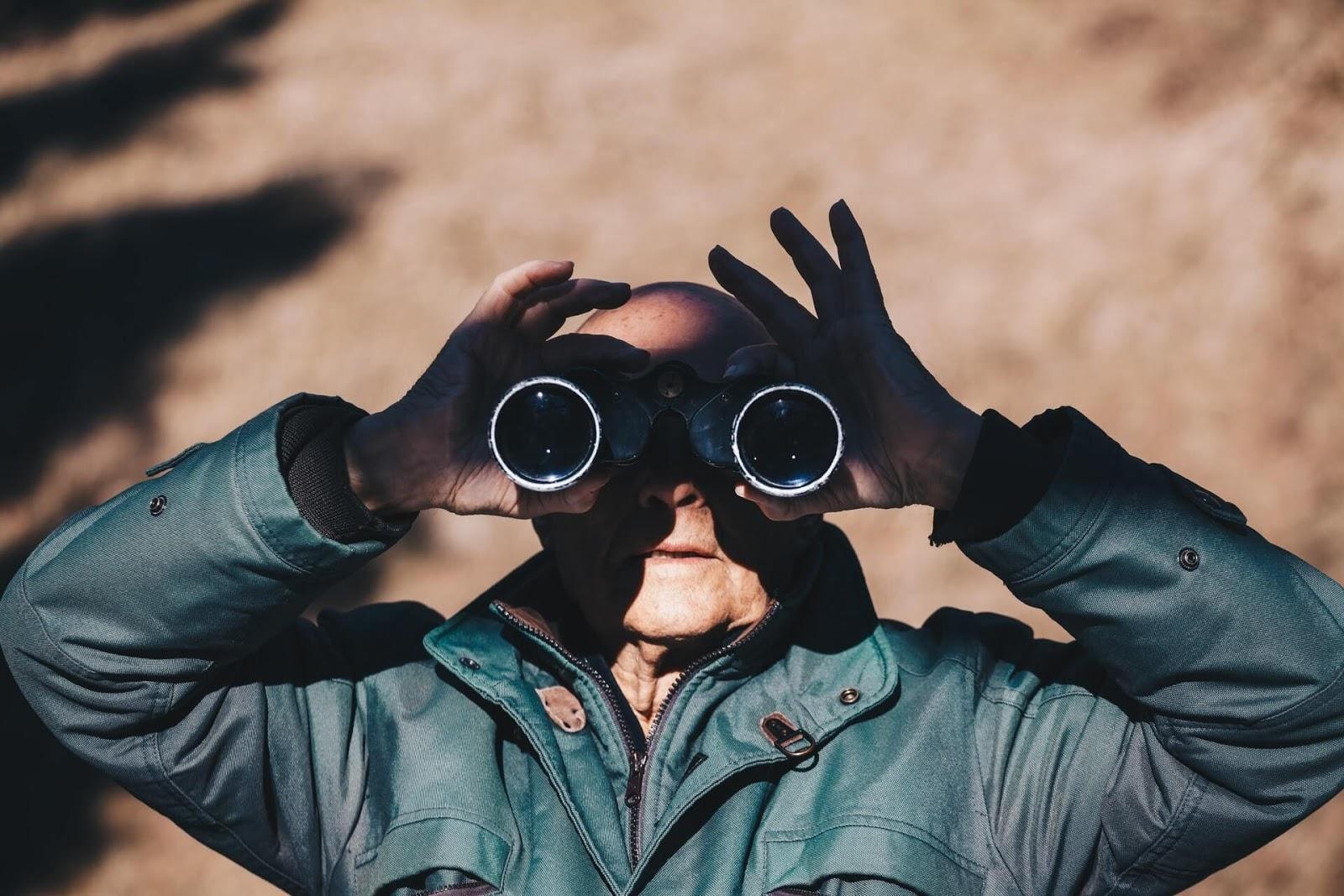
While there are many well-performing thermal bi-oculars and monoculars on the market, binoculars are superior to them since they receive two times the information from your surroundings, have a wider field of vision, and produce higher quality images.
So, which are the best thermal binoculars? In our opinion, Pulsar Accolade XP50 2.5-20x42 Thermal Binoculars take the prize. It has a 640×480 resolution and a 50 Hz refresh rate which produces high-quality, smooth images. Its detection range is also superior, and some operators can even spot animals from 2900 yards away.
The Pulsar Accolade XP50 also has adjustable interpupillary distance and a rangefinder that tells you how far away the object you’re looking at is. Lastly, it has a battery life that will last you all day and is water- and dustproof.
These binoculars come at a rather hefty price, however. If you’re looking for a cheaper alternative, ATN OTS-HD 640 Thermal Smart HD Monoculars have superior zoom-range and great image quality, which makes them our more affordable runner-up and the best thermal monocular.
But which binoculars (or monoculars) suit you the best?













